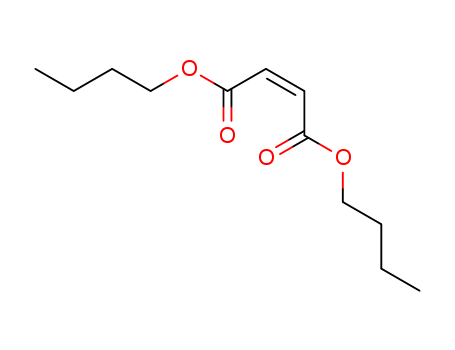Reputable Factory Supply Reliable Quality Dibutyl maleate 105-76-0 with Competitive Price
- Molecular Formula:C12H20O4
- Molecular Weight:228.288
- Appearance/Colour:clear colourless to slightly yellowish liquid
- Vapor Pressure:0.0027 hPa (20 °C)
- Melting Point:-85 °C
- Refractive Index:1.445 - 1.446
- Boiling Point:280 °C at 760 mmHg
- Flash Point:136.4 °C
- PSA:52.60000
- Density:1.004 g/cm3
- LogP:2.22920
Dibutyl maleate(Cas 105-76-0) Usage
|
Safety Profile
|
Poison by intraperitoneal route. Moderately toxic by ingestion. Mddly toxic by skin contact. An eye and skin irritant. See also ESTERS and n-BUTYL ALCOHOL. Combustible when exposed to heat or flame; can react with oxilzing materials. To fight fire, use foam, CO2, dry chemical, alcohol foam. When heated to decomposition it emits acrid smoke and irritating fumes.
|
InChI:InChI=1/C12H20O4/c1-3-5-9-15-11(13)7-8-12(14)16-10-6-4-2/h7-8H,3-6,9-10H2,1-2H3/b8-7-
105-76-0 Relevant articles
Diacidic ionic liquid supported on magnetic-silica nanocomposite: a novel, stable, and reusable catalyst for selective diester production
Fareghi-Alamdari, Reza,Nadiri Niri, Mehri,Hazarkhani, Hassan,Zekri, Negar
, p. 2615 - 2629 (2018)
Abstract: Supported diacidic ionic liqui...
Ionic Immobilization of Silicotungstic Acid on Amine-Functionalized Zirconia: A Mesoporous Catalyst for Esterification of Maleic Acid
Ramalingam, Meenakshi,Manickam, Sundar,Srinivasalu, Kutti Rani,Ismail, Mohammed Bilal,Deivanayagam, Easwaramoorthy
, p. 1697 - 1705 (2016)
Silicotungstic acid (H4SiW12O40) has bee...
Role of the succinate skeleton in the disorder-order transition of AOT and its analogous molecules: Detection by infrared absorption spectra of the configurations arising from the difference in torsion angles of the succinate skeleton
Okabayashi, Hiro-Fumi,Izawa, Ken-Ichi,Sumiya, Akiko,Eastoe, Julian,O'Connor, Charmian J.
, p. 651 - 659 (2010)
The IR spectra in the 13001450 cm-1 regi...
Esterification of maleic acid and butanol using cationic exchange resin as catalyst
Mulay, Aarti,Rathod
, p. 1713 - 1720 (2017)
Abstract : Dibutyl maleate is a perfumer...
Synthesis and characterization of a new hydroxyl functionalized diacidic ionic liquid as catalyst for the preparation of diester plasticizers
Fareghi-Alamdari, Reza,Nadiri Niri, Mehri,Hazarkhani, Hassan
, p. 153 - 160 (2017)
Two new functionalized diacidic ionic li...
Method for preparing maleate by catalyzing maleic anhydride with ionic liquid
-
Paragraph 0045; 0048; 0049; 0052, (2020/02/29)
The invention discloses a method for pre...
Method for preparing succinate by double carbonylation of acetylene
-
Paragraph 0027-0038, (2019/12/02)
The invention provides a method for prep...
105-76-0 Process route
-
- 105-76-0,29014-71-9
Dibutyl maleate
-
- 2050-60-4
di-n-butyl oxalate
-
- 141-03-7
dibutyl succinate
-
- 1587-18-4,6280-99-5
L-(-)-di-n butyl malate
-
- 344268-32-2,15763-01-6
dibutyl tartrate
-
- 38094-11-0
propane-1,2,3-tricarboxylic acid tributyl ester
-
- 105-75-9,29014-71-9
dibutyl fumarate
Conditions
| Conditions |
Yield |
|
Glyoxilic acid; With sodiumsulfide nonahydrate; In water; at 90 ℃; for 168h;
butan-1-ol; With hydrogenchloride; at 90 ℃; for 2h;
|
|
-
- 201230-82-2
carbon monoxide
-
- 74-86-2,25067-58-7
acetylene
-
- 105-76-0,29014-71-9
Dibutyl maleate
-
- 141-03-7
dibutyl succinate
-
- 105-75-9,29014-71-9
dibutyl fumarate
Conditions
| Conditions |
Yield |
|
With 2-hydroxypyridin; methanesulfonic acid; lithium bromide; palladium(II) bromide; In acetonitrile; at 40 ℃; for 4h; under 750.075 Torr; Overall yield = 90.1 percent; Inert atmosphere;
|
57.03%
2.81%
30.26% |
105-76-0 Upstream products
-
110-16-7
maleic acid
-
71-36-3
butan-1-ol
-
201230-82-2
carbon monoxide
-
74-86-2
acetylene
105-76-0 Downstream products
-
63842-87-5
butoxy-succinic acid dibutyl ester
-
105-75-9
dibutyl fumarate
-
10042-89-4
3-thia-pentane-1,2,4,5-tetracarboxylic acid tetrabutyl ester
-
106-98-9
1-butylene


















